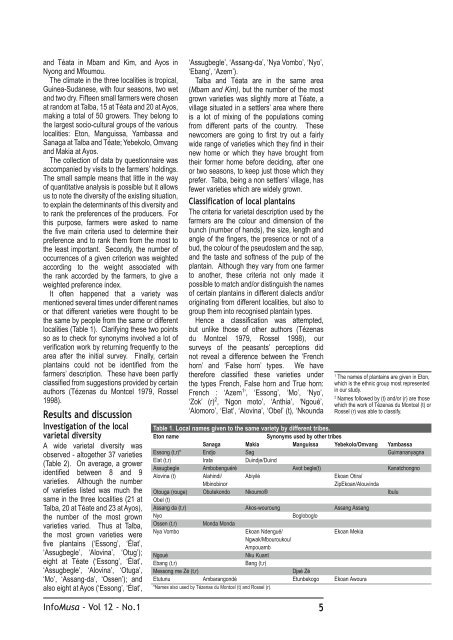Château-Musa - Bioversity International
Château-Musa - Bioversity International
Château-Musa - Bioversity International
Create successful ePaper yourself
Turn your PDF publications into a flip-book with our unique Google optimized e-Paper software.
and Téata in Mbam and Kim, and Ayos in<br />
Nyong and Mfoumou.<br />
The climate in the three localities is tropical,<br />
Guinea-Sudanese, with four seasons, two wet<br />
and two dry. Fifteen small farmers were chosen<br />
at random at Talba, 15 at Téata and 20 at Ayos,<br />
making a total of 50 growers. They belong to<br />
the largest socio-cultural groups of the various<br />
localities: Eton, Manguissa, Yambassa and<br />
Sanaga at Talba and Téate; Yebekolo, Omvang<br />
and Makia at Ayos.<br />
The collection of data by questionnaire was<br />
accompanied by visits to the farmers’ holdings.<br />
The small sample means that little in the way<br />
of quantitative analysis is possible but it allows<br />
us to note the diversity of the existing situation,<br />
to explain the determinants of this diversity and<br />
to rank the preferences of the producers. For<br />
this purpose, farmers were asked to name<br />
the five main criteria used to determine their<br />
preference and to rank them from the most to<br />
the least important. Secondly, the number of<br />
occurrences of a given criterion was weighted<br />
according to the weight associated with<br />
the rank accorded by the farmers, to give a<br />
weighted preference index.<br />
It often happened that a variety was<br />
mentioned several times under different names<br />
or that different varieties were thought to be<br />
the same by people from the same or different<br />
localities (Table 1). Clarifying these two points<br />
so as to check for synonyms involved a lot of<br />
verification work by returning frequently to the<br />
area after the initial survey. Finally, certain<br />
plantains could not be identified from the<br />
farmers’ description. These have been partly<br />
classified from suggestions provided by certain<br />
authors (Tézenas du Montcel 1979, Rossel<br />
1998).<br />
Results and discussion<br />
Investigation of the local<br />
varietal diversity<br />
A wide varietal diversity was<br />
observed - altogether 37 varieties<br />
(Table 2). On average, a grower<br />
identified between 8 and 9<br />
varieties. Although the number<br />
of varieties listed was much the<br />
same in the three localities (21 at<br />
Talba, 20 at Téate and 23 at Ayos),<br />
the number of the most grown<br />
varieties varied. Thus at Talba,<br />
the most grown varieties were<br />
five plantains (‘Essong’, ‘Élat’,<br />
‘Assugbegle’, ‘Alovina’, ‘Otug’);<br />
eight at Téate (‘Essong’, ‘Élat’,<br />
‘Assugbegle’, ‘Alovina’, ‘Otuga’,<br />
‘Mo’, ‘Assang-da’, ‘Ossen’); and<br />
also eight at Ayos (‘Essong’, ‘Élat’,<br />
‘Assugbegle’, ‘Assang-da’, ‘Nya Vombo’, ‘Nyo’,<br />
‘Ebang’, ‘Azem’).<br />
Talba and Téata are in the same area<br />
(Mbam and Kim), but the number of the most<br />
grown varieties was slightly more at Téate, a<br />
village situated in a settlers’ area where there<br />
is a lot of mixing of the populations coming<br />
from different parts of the country. These<br />
newcomers are going to first try out a fairly<br />
wide range of varieties which they find in their<br />
new home or which they have brought from<br />
their former home before deciding, after one<br />
or two seasons, to keep just those which they<br />
prefer. Talba, being a non settlers’ village, has<br />
fewer varieties which are widely grown.<br />
Classification of local plantains<br />
The criteria for varietal description used by the<br />
farmers are the colour and dimension of the<br />
bunch (number of hands), the size, length and<br />
angle of the fingers, the presence or not of a<br />
bud, the colour of the pseudostem and the sap,<br />
and the taste and softness of the pulp of the<br />
plantain. Although they vary from one farmer<br />
to another, these criteria not only made it<br />
possible to match and/or distinguish the names<br />
of certain plantains in different dialects and/or<br />
originating from different localities, but also to<br />
group them into recognised plantain types.<br />
Hence a classification was attempted,<br />
but unlike those of other authors (Tézenas<br />
du Montcel 1979, Rossel 1998), our<br />
surveys of the peasants’ perceptions did<br />
not reveal a difference between the ‘French<br />
horn’ and ‘False horn’ types. We have<br />
therefore classified these varieties under<br />
the types French, False horn and True horn:<br />
French : ‘Azem 1 ’, ‘Essong’, ‘Mo’, ‘Nyo’,<br />
‘Zok’ (r) 2 , ‘Ngon moto’, ‘Anthia’, ‘Ngoué’,<br />
‘Alomoro’, ‘Elat’, ‘Alovina’, ‘Obel’ (t), ‘Nkounda<br />
Table 1. Local names given to the same variety by different tribes.<br />
Eton name Synonyms used by other tribes<br />
Sanaga Makia Manguissa Yebekolo/Omvang Yambassa<br />
Essong (t,r)* Endjo Sag Guimananyagna<br />
Elat (t,r) Irata Duindje/Duind<br />
Assugbegle Ambobenguéré Avot begle(t) Kanatchongno<br />
Alovina (t) Alahindi/ Abiyilé Ekoan Otira/<br />
Mbinobinor ZipEkoan/Alouvinda<br />
Otouga (rouge) Obutekondo Nkoumo® Ibulu<br />
Obel (t)<br />
Assang da (t,r) Akos-wouroung Assang Assang<br />
Nyo Bogloboglo<br />
Ossen (t,r) Monda Monda<br />
Nya Vombo Ekoan Ndengué/ Ekoan Mekia<br />
Ngwak/Mbouroukou/<br />
Ampouamb<br />
Ngoué Nku Kuant<br />
Ebang (t,r) Bang (t,r)<br />
Messong me Zé (t,r) Djaé Zé<br />
Etutunu Ambarangondé Etunbekogo Ekoan Awoura<br />
*Names also used by Tézenas du Montcel (t) and Rossel (r).<br />
Info<strong>Musa</strong> - Vol 12 - No.1 5<br />
1 The names of plantains are given in Eton,<br />
which is the ethnic group most represented<br />
in our study.<br />
2 Names followed by (t) and/or (r) are those<br />
which the work of Tézenas du Montcel (t) or<br />
Rossel (r) was able to classify.

















